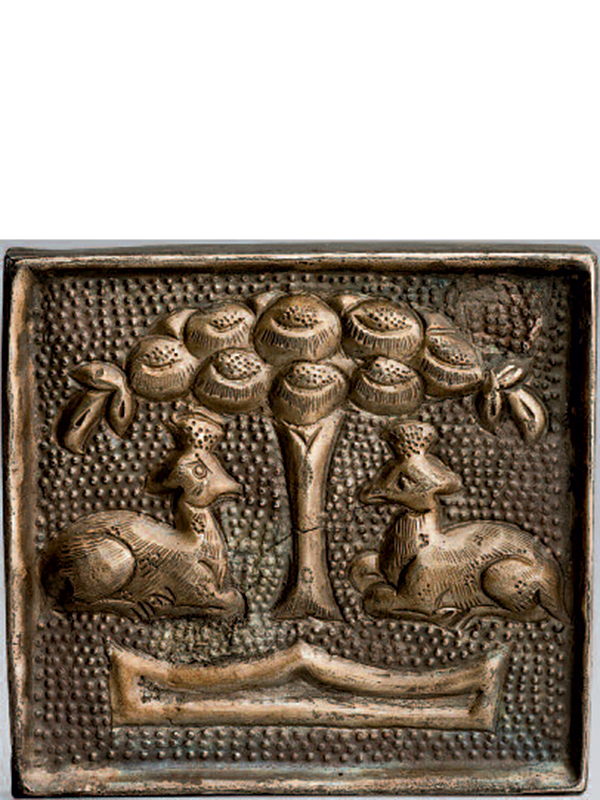Silver and partially gilded belt plaque
A silver belt plaque of rectangular form, the short sides folded over. The front of the plaque is decorated in repoussé with two deer, confronting each other and depicted in a recumbent pose on either side of a tree that bears large fruit and leaves and grows above a basin-shaped ornament. Each deer’s head is crowned by a lingzhi crest and the animal’s fur is indicated by finely incised lines. The design is set against a ground of small raised dots. The raised parts of the design are gilded.
This partly gilded silver plaque was originally used as an ornament on a leather belt, possibly worn by a high-rank official. Deer are popular as a motif both in the Song (960 – 1127) and Liao dynasties, although their meanings are different. In the Song dynasty they represent Luxing, the God of rank and emolument in Chinese mythology and symbolize longevity.[1] In this capacity, they are often found on ceramics.[2] For the Qidan people during the Liao dynasty, deer are worshipped by Tungusic shamans and are objects for hunting.[3] A set of gilded silver belt ornamental plaques with closely comparable deer motifs and decoration is in the Mengdiexuan Collection.[4] Writing in Noble Risers from Pines and Deserts – The Artistic Legacy of the Qidan, So points out that a set of gilded silver ornamental plaques, each with twin deer decoration as the main motif, was excavated from a Qidan tomb at Zhangwu in Liaoning province.[5]
PROVENANCE
Collection of Prof. Michael Besser, London
- Tse Bartholomew, T. Hidden Meanings in Chinese Art, Asian Art Museum, San Francisco, 2006, 5.7, p. 108
- For a cizhou stoneware pillow decorated with two deer, dated to the Northern Song dynasty, see Ben JanssensOriental Art, 2005 catalogue, p. 58
- So, J. F. Noble Risers from Pines and Deserts – The Artistic Legacy of the Qidan, Art Museum, The Chinese University of Hong Kong, p. 226
- So, J. F. op. cit., V:13, p. 226.7
- Liaoning Provincial Institute of Cultural Relics and Archaeology ed. Liaonign Kaogu Wenji (Collection of Archaeological Paperson Liaoning),Shenyang: Liaoning Nationalities Publishing House, 2003, pl. 15:3 and 5; So J.F. op. cit., note 6, p. 226

